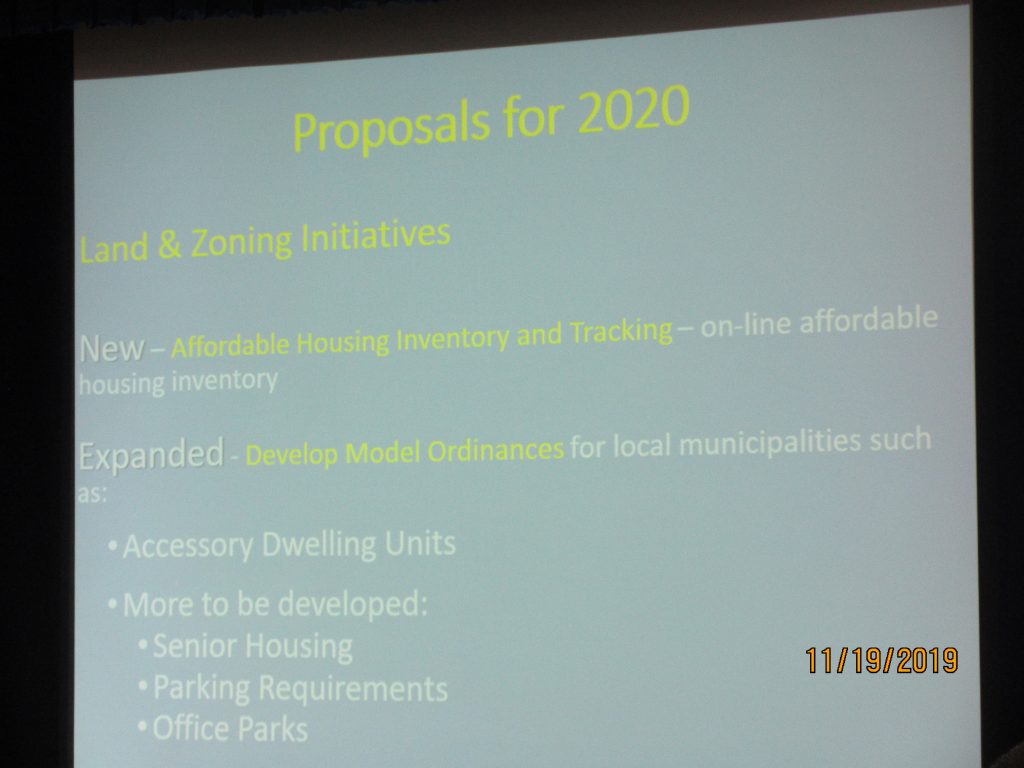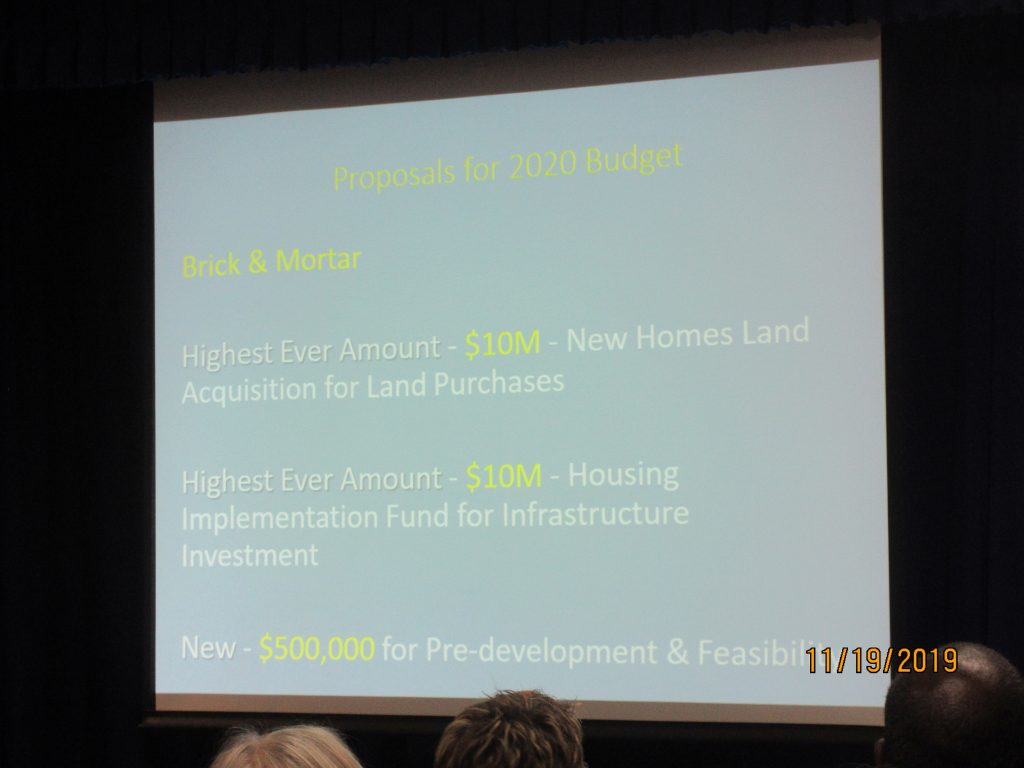Hits: 90
Comprehensive Report Reveals. County Executive outlines Plan of Action.
UNTOLD Billions in Financing Needed Unclear.
County Plans Approaching Communities in January to Identify Possible Sites.
WPCNR COUNTY CLARION-LEDGER. By John F. Bailey. November 19, 2019:
County Executive George Latimer stunned a news conference this afternoon with a 175-page Report , “The Westchester County Housing Needs Assessment,” prepared by Hudson Valley Plan for Progress that stated the county needs 82,451 units to fill a gap in affordable housing– make the county attractive to firms considering relocating to Westchester –bring in a viable workforce that can afford to live in the county.
To put that figure into perspective, over the last 6 years approximately 900 affordable units have been built by the County. A White Plains Affordable Housing Effort the mixed-use public-private partnership has been ongoing for 11 years and only one building of 5 has been completed, primarily due to financing difficulties and the third has just broken ground.
County Executive Latimer and Commissioner of Planning, Norma Drummond outlined the County Executive’s plan for action which will begin in January with a reaching out to communities in the county.

The County Executive emphasized there have been no quotas for each community established determining which communities need affordable housing and how much. The effort to isolate possible potentialities for affordable housing, units, buildings and sites will be undertaken in January working cooperatively with individual cities and communities.
The Assessment described a sweeping commitment of funds by the county in the proposed 2020 Budget to facilitate the affordable housing initiative.
In response to a question by WPCNR, Mr. Latimer said it was unclear whether the Housing and Urban Development department was going to be willing to finance such projects, (though the New York State HUD as given the Count $4 Million, or whether New York State would providing funding for the units needed to be built.
Latimer said the New York delegation in Washington in the Senate and the House of Representatives could be expect to work hard for the by WPCNR estimate billions to put up the bricks and mortar for new units; rehabilitation of substandard housing; anti-foreclosure efforts, and identification of potential sites city by city.
Latimer at the conclusion of the news conference said the primary focus would have to be more Section 8 funding to increase rapidly the availability of existing buildings at affordable rents.

Report is available at:
www.westchestergov.com/housing-needs-assessment

The report is available on the Westchester County website, Latimer said, and he welcome community comments on the report which is chock full of alarming demographics of who rents what, what they pay, who owns their homes, which WPCNR will delve into in this developing story.
According to the County Press Release just published, these statistics are intriguing:
· There are 345,885 housing units in Westchester; 81% of the housing units in the county were built before 1979;
· The City of Yonkers has the most housing units with 82,562; the Village of Buchanan has the fewest with only 864;
· 62% of the County’s units are ownership – slightly lower than the 63% national average; while 38% are rental units;
· There are 2,476 Public Housing Units and 13,092 Section 8 Housing Choice Vouchers units;
· There are 34,221 ETPA (Emergency Tenant Protection Act) units in 1,773 buildings in the county;
· 141,570 households (41.4% of the total number in the county) are living in homes and apartments that are paying more than 50% of their income toward their housing costs;
· There is a significant shortage of housing for extremely low income renters, people with disabilities, seniors, large families and the homeless; In particular, families and individuals who face intellectual and developmental disabilities, who need specialized housing with services, are not being adequately served;
· There are 89,839 people living in poverty in Westchester (9.4% of the total population);
· The greatest growth in population is in the 85 and over cohort (e.g. the Towns of Lewisboro and Pound Ridge with 232% and 202% increases respectively), between 2000 and 2017, demonstrating the need for senior housing;
· The combined population of the five largest cities represent 46% of the total population in the county;
· The 30-44 age cohort shows decline, which may mean there aren’t enough affordable housing options for young families;
· More people commute into Westchester to work than those who live and work in the county; the majority of commuters (58%) drive alone to work;
· There is no municipality where the market rate rent for a 2-BR unit is affordable to households earning the local hourly renter wage; the greatest monthly gap, at $1,823, is in the Village of Pleasantville; municipalities with gaps over $1,700 are in the City of Peekskill, the Town of Bedford and the Village of Port Chester;
· There are only three municipalities where the HUD FMR is affordable to households earning the local hourly renter wage – the Town of New Castle, and the villages of Bronxville and Pelham Manor;
· The Housing Action Council found that 68.6% of households seeking housing under the Housing Settlement were already living in Westchester; there were 9,260 applicants for 395 affordable rental units in development – a ratio of 23 applicants for every unit of rental housing; and
· The combined population of persons with disabilities in the cities of Peekskill, Yonkers and Mount Vernon account for 42% of the county’s population with a disability.
In this report, the three major components of the data analysis: Housing Cost Burden, Housing Conditions and a Projection of Current Housing Need are provided at the County level and for each municipality.
· The finding that 50.7% of all owner households earning between 30% and 50% of the County’s Area Median Income (AMI) are severely cost burdened should not be a surprise, but the conclusion that 22.9% of households earning between 80% and 100% of AMI might be (when one considers that a family of 4 at 100% AMI earns approximately $117,100 in Westchester County). It is important to note that these households have housing; but they cannot comfortably afford it.
· Similarly, the Assessment concludes that 2,556 households in the county live in substandard housing.
· The Assessment also concludes that 4,523 households are severely overcrowded.
Data compiled under these three components of housing need document the county’s existing housing stock with one or more problems as 75,271 units(22% of all units in the county). This is the greatest portion of the need for affordable housing in Westchester County, but does not reflect the entire need.
Collectively, all these data sources tell us that the need for affordable housing in Westchester County totals 82,451 units; however the greatest portion of these units are not substandard, so addressing the affordability of some portion of these units could be through rental assistance programs like the federal Housing Choice Voucher (Section 8) program.
The total number of new affordable housing units needed is 11,703. This represents the total number of Westchester households that are severely overcrowded or Homeless, as well as the non-Westchester Homeseeker registrants.
In response to the data found and the analysis conducted, this Assessment includes 12 Recommendations for the County to consider for implementation to start to address the identified need. Many of these recommendations are included in the Latimer’ proposed 2020 budget. The 12 Recommendations are:
1: Affordable Housing Education Workshop Series: Contract with an organization with a focus on housing policy, education, technical assistance and municipal engagement to establish a series of workshops to facilitate educational sessions regarding affordable housing.
2: Increase the Community Based Organization Capacity: Establish an annual funding allocation to cover the tuition associated with professional certification programs in housing and community development through NeighborWorks America®.
3: Housing Inventory & Tracking System: Conduct a bi-annual update of the existing affordable housing inventory – utilizing the existing housing inventory database. Establish a permanent tracking and monitoring system of all housing developments over 10 units. Share with economic development entities and Industrial Development Agencies to ensure housing and wages are in alignment.
4: Community Land Trust: Create a countywide community land trust and focus on capturing housing headed into foreclosure as an eviction prevention strategy, but keeping it flexible to address a multitude of development concerns.
5: Municipal Ordinances: Design a formal program to provide technical assistance to municipalities to draft model ordinances for example, Accessory Dwelling Units, specifically targeted for affordable housing.
6: Adaptive Reuse of Under-Utilized Property: Design a property disposition program for the adaptive re-use of land and buildings, including older office park campuses, for the purpose of developing new affordable housing.
7: Housing Compact between County and Municipalities: Gather support from the local businesses, municipalities and community based organizations to work together to meet the needs of affordable housing in the County.
8: Neighborhood Revitalization Opportunities: Utilize the Affordable Housing Needs Assessment data in addition to existing web-based systems to explore the specific needs of individual neighborhoods and establish a data rich system to analyze community conditions.
9: Eviction and Foreclosure Prevention Services: Expand existing eviction and foreclosure prevention programs.
10: Employer Assisted Housing Program: Establish an Employer Assisted Housing program by creating public-private partnerships with major employers, hospitals, county staff and large-scale not-for-profit housing providers and healthcare agencies.
11: Pre-development and Preservation Options: Create and provide funding for not-for-profit housing agencies for pre-development costs associated with the construction and preservation of affordable housing.
12: Funding Opportunities: Offers a couple of examples of options to provide a source of funding to undertake the recommendations above and increase the funding stream for the County’s affordable housing programs.
The County’s next steps will shape the conversation on affordable housing for the foreseeable future.
